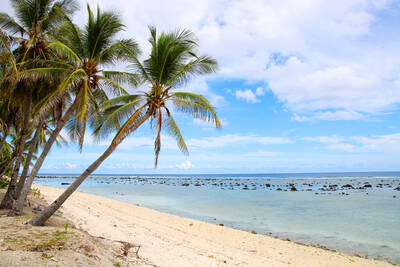Mortality rates worldwide among adults under 60 have dropped over the past four decades by 34 percent for women and 19 for men, but show a sharp increase in inequality across nations, according to a major study released yesterday.
The new tally of adult mortality shows that a 15-year-old girl in the country with the worst female death rate today, Zambia, is 16 times more likely to die before reaching the sixth decade of life than her counterpart in Cyprus, the nation on top of the ranking.
Of 1,000 young women in Zambia who are 15 today, in other words, less than 400 are predicted to reach the age of 60.
More broadly, the rates of mortality across all of southern Africa are, this year, higher than they were in Sweden in 1751, nearly two centuries before the widespread production of life-saving antibiotics, the study showed.
“With adult mortality, we are seeing this massive spread between the best and the worst off,” said Christopher Murray, director of the Institute for Health Metrics and Evaluation at the University of Washington in Seattle and the main architect of the study.
This stands in sharp contrast to the major progress since 1970 in both maternal mortality and children, he said in a statement.
Globally, the research confirms a reassuring downward trend in the rate of adult mortality over the period studied, 1970 to this year.
However, there were two regions that showed an alarming uptick in adult deaths in the 1990s, both for very different reasons, according to the study, published in the British journal The Lancet.
In much of sub-Saharan Africa, the backslide was most likely due to the HIV/AIDS epidemic, which has killed nearly 1.5 million people there annually in recent years.
During the same period, Eastern Europe saw one of the largest public health reversals of modern times after the collapse of the Soviet Union in 1991. In the ranking of 187 nations, adult female mortality in Russia fell from 43rd in 1970 to 121 this year.
In Belarus, the drop over the same period was from 38th to 108th for women, and 81st to 150th for men, while Bulgaria plummeted from 14th and 12th in 1970 to 66th and 96th respectively this year.
The study — based on registration data, census data and records of household deaths rather than indirectly inferred from infant mortality, the method used up to now — also shows that the risk of premature death has almost always been higher in men, sometimes twice as high.
The pattern emerging from each region is somewhat different.
In 1970, South Asia had the highest level of female mortality, but by this year it had declined by 56 percent.
Male mortality went down sharply over most of Asia, with Australia jumping from 44th to 6th place over the four decades under review.
The rankings of some wealthy nations for both men and women are less favorable now than they were in 1990, partly because of improvements in health elsewhere, but also due to an epidemic of “lifestyle” diseases related in particular to obesity.
The US slipped from 34th and 41st place for men and women in 1990 to 49th and 45th respectively this year.
The five countries now with the lowest male adult mortality are, in order, Iceland, Sweden, Malta, the Netherlands and Switzerland. For women, the countries are Cyprus, South Korea, Japan, Greece, Italy and Spain.
Over the four-decade period South Korea made spectacular gains, with its ranking for men rising from 167 to 31, and for women from 123 to 2.
Funding for the research came from the Bill and Melinda Gates Foundation.

Nauru has started selling passports to fund climate action, but is so far struggling to attract new citizens to the low-lying, largely barren island in the Pacific Ocean. Nauru, one of the world’s smallest nations, has a novel plan to fund its fight against climate change by selling so-called “Golden Passports.” Selling for US$105,000 each, Nauru plans to drum up more than US$5 million in the first year of the “climate resilience citizenship” program. Almost six months after the scheme opened in February, Nauru has so far approved just six applications — covering two families and four individuals. Despite the slow start —

YELLOW SHIRTS: Many protesters were associated with pro-royalist groups that had previously supported the ouster of Paetongtarn’s father, Thaksin, in 2006 Protesters rallied on Saturday in the Thai capital to demand the resignation of court-suspended Thai Prime Minister Paetongtarn Shinawatra and in support of the armed forces following a violent border dispute with Cambodia that killed more than three dozen people and displaced more than 260,000. Gathered at Bangkok’s Victory Monument despite soaring temperatures, many sang patriotic songs and listened to speeches denouncing Paetongtarn and her father, former Thai prime minister Thaksin Shinawatra, and voiced their backing of the country’s army, which has always retained substantial power in the Southeast Asian country. Police said there were about 2,000 protesters by mid-afternoon, although

MOGAMI-CLASS FRIGATES: The deal is a ‘big step toward elevating national security cooperation with Australia, which is our special strategic partner,’ a Japanese official said Australia is to upgrade its navy with 11 Mogami-class frigates built by Japan’s Mitsubishi Heavy Industries, Australian Minister for Defence Richard Marles said yesterday. Billed as Japan’s biggest defense export deal since World War II, Australia is to pay US$6 billion over the next 10 years to acquire the fleet of stealth frigates. Australia is in the midst of a major military restructure, bolstering its navy with long-range firepower in an effort to deter China. It is striving to expand its fleet of major warships from 11 to 26 over the next decade. “This is clearly the biggest defense-industry agreement that has ever

DEADLY TASTE TEST: Erin Patterson tried to kill her estranged husband three times, police said in one of the major claims not heard during her initial trial Australia’s recently convicted mushroom murderer also tried to poison her husband with bolognese pasta and chicken korma curry, according to testimony aired yesterday after a suppression order lapsed. Home cook Erin Patterson was found guilty last month of murdering her husband’s parents and elderly aunt in 2023, lacing their beef Wellington lunch with lethal death cap mushrooms. A series of potentially damning allegations about Patterson’s behavior in the lead-up to the meal were withheld from the jury to give the mother-of-two a fair trial. Supreme Court Justice Christopher Beale yesterday rejected an application to keep these allegations secret. Patterson tried to kill her